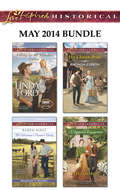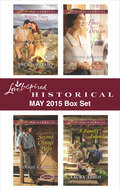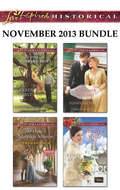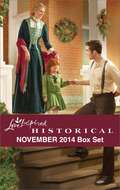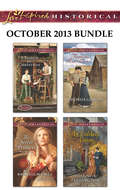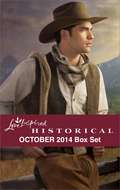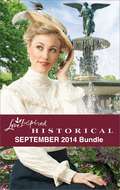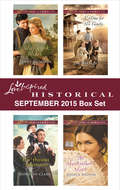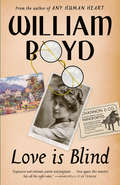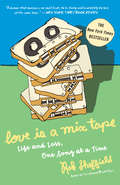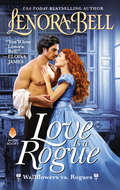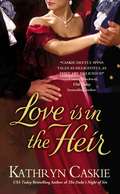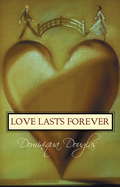- Table View
- List View
Love Inspired Historical May 2014 Bundle
by Linda Ford Karen Kirst Lily George Rhonda GibsonLove Inspired Historical brings you four new titles for one great price, available now! This Love Inspired Historical bundle includes Falling for the Rancher Father by Linda Ford, The Horseman's Frontier Family by Karen Kirst, His Chosen Bride by Rhonda Gibson and A Rumored Engagement by Lily George.Look for four new inspirational suspense stories every month from Love Inspired Suspense!
Love Inspired Historical May 2015 Box Set
by Laura Abbot Winnie Griggs Christine Johnson Lacy WilliamsLove Inspired Historical brings you four new titles for one great price, available now! This Love Inspired Historical bundle includes Wagon Train Sweetheart by Lacy Williams, Second Chance Hero by Winnie Griggs, Love by Design by Christine Johnson and A Family Found by Laura Abbot.Look for 4 new inspirational suspense stories every month from Love Inspired Historical!
Love Inspired Historical May 2017 Box Set: The Nanny's Temporary Triplets\Her Cherokee Groom\An Unlikely Mother\The Marshal's Mission
by Valerie Hansen Noelle Marchand Danica Favorite Anna ZoggLove Inspired Historical brings you four new titles! Enjoy these historical romances of adventure and faith.THE NANNY’S TEMPORARY TRIPLETSLone Star Cowboy League: Multiple Blessingsby Noelle MarchandAfter being jilted at the altar, Caroline Murray becomes the temporary nanny for David McKay’s daughter and the orphaned triplet babies he’s fostering. But when she starts to fall for the handsome widower, can she trust her heart?HER CHEROKEE GROOMby Valerie HansenWhen lovely Annabelle Lang is wrongly accused of murder after rescuing him, Cherokee diplomat Charles McDonald must do something! To save their lives—and their reputations—Charles proposes a marriage of convenience. But will this business proposition turn to one of true love?AN UNLIKELY MOTHERby Danica FavoriteWhen George Baxter, who is working undercover at his family’s mine, finds a young boy who’s lost his father, he’s determined to reunite them. Caring for the boy with the help of Flora Montgomery, his former childhood nemesis, he instead discovers hope for a family of his own.THE MARSHAL’S MISSIONby Anna ZoggHunting a gang of bank robbers, US Marshal Jesse Cole goes undercover as a horse breeder working for Lenora Pritchard. But when he discovers the widowed single mother he’s slowly falling for may know something about the crime, can he convince her to tell him her secret?Join HarlequinMyRewards.com to earn FREE books and more. Earn points for all your Harlequin purchases from wherever you shop.
Love Inspired Historical May 2018 Box Set: His Substitute Mail-Order Bride\Baby on Her Doorstep\Accidental Sweetheart\Last Chance Wife
by Lisa Bingham Rhonda Gibson Sherri Shackelford Janette ForemanLove Inspired Historical brings you four new titles! Enjoy these historical romances of adventure and faith.HIS SUBSTITUTE MAIL-ORDER BRIDEReturn to Cowboy Creekby Sherri ShackelfordWhen the bride train arrives in Cowboy Creek, Russ Halloway is shocked to discover his carefully selected mail-order bride is instead his ex-fiancée’s little sister—all grown up. Anna Linford’s looking for a fresh start—and to keep her secrets hidden from the one man who, should he discover them, could break her heart.BABY ON HER DOORSTEPby Rhonda GibsonTo raise the little girl left on her doorstep, schoolteacher Laura Lee’s only option is becoming a temporary live-in nanny for rancher Clint Shepard. The arrangement was supposed to be temporary, but soon the single dad’s wishing Laura and her baby can become a permanent part of his family.ACCIDENTAL SWEETHEARTThe Bachelors of Aspen Valleyby Lisa BinghamLydia Tomlinson will do anything to keep stranded mail-order brides in the Batchwell Bottoms mining camp—even going up against Pinkerton detective Gideon Gault, who watches over the ladies. But when a gang of outlaws threatens the town, Gideon and Lydia must band together to stop the thieves—and to fight any force that would keep them apart.LAST CHANCE WIFEby Janette ForemanStranded in Deadwood, Dakota Territory, after a failed mail-order match, Winifred Sattler convinces Ewan Burke to give her a job in the general store attached to his gold mine. Busy trying to keep his fledgling operation open, Ewan has no time for distractions—except he can’t stop picturing his life with Winifred by his side…forever.
Love Inspired Historical November 2013 Bundle
by Penny Richards Deborah Hale Renee Ryan Karen KirstLove Inspired Suspense brings you four new titles for one great price, available now for a limited time only from November 1 to November 30! Enjoy these contemporary heart-pounding tales of suspense, romance, hope and faith. This Love Inspired Suspense bundle includes The Husband Hunt by Karen Kirst, The Duke's Marriage Mission by Deborah Hale, Wolf Creek Wedding by Penny Richards and Finally a Bride by Renee Ryan.Look for four new inspirational suspense stories every month from Love Inspired Suspense!
Love Inspired Historical November 2014 Box Set
by Winnie Griggs Regina Scott Rhonda Gibson Danica FavoriteLove Inspired Historical brings you four new titles for one great price, available now! This Love Inspired Historical bundle includes Her Holiday Family by Winnie Griggs, The Bride Ship by Regina Scott, A Pony Express Christmas by Rhonda Gibson and Rocky Mountain Dreams by Danica Favorite. Look for four new inspirational suspense stories every month from Love Inspired Historical!
Love Inspired Historical November 2015 Box Set
by Linda Ford Janet Lee Barton Karen Kirst Sherri ShackelfordLove Inspired Historical brings you four new titles at a great value, available now! Enjoy these historical romances of adventure and faith.A BABY FOR CHRISTMASChristmas in Eden ValleyLinda FordFor widow Louise Porter, a temporary marriage to Nate Hawkins seems the only solution to protect her unborn child. But it could also give her a second chance at happiness?if she's willing to risk her wounded heart once more. THE RANCHER'S CHRISTMAS PROPOSAL Prairie CourtshipsSherri ShackelfordWanting a mother for his twins, Shane McCoy proposes a marriage of convenience to Tessa Spencer. However, will Shane realize that this wedding could be the start of a love for a lifetime? THE BACHELOR'S HOMECOMING Smoky Mountain Matches Karen KirstJane O'Malley offered her heart to Tom Leighton, but he only had eyes for her sister. Now back in town after several years' absence and the guardian of his niece, Tom is beginning to see Jane in a whole new light. THE MISTLETOE KISS Boardinghouse Betrothals Janet Lee Barton When fiercely independent Millicent Faircloud is assigned to photograph the skyscraper Matthew Sterling is building, can they set their differences aside to find joy--and love--this holiday season?
Love Inspired Historical November 2017 Box Set: A Lawman for Christmas\Mail-Order Christmas Baby\Their Mistletoe Matchmakers\A Child's Christmas Wish
by Karen Kirst Sherri Shackelford Keli Gwyn Erica VetschLove Inspired Historical brings you four new titles! Enjoy these historical romances of adventure and faith.A LAWMAN FOR CHRISTMASSmoky Mountain Matchesby Karen KirstAfter lawman Ben MacGregor and avowed spinster Isabel Flores discover a four-year-old boy abandoned on her property at Christmas, they must work together to care for him. But can their temporary arrangement turn into a forever family? MAIL-ORDER CHRISTMAS BABYMontana Courtshipsby Sherri ShackelfordWhen a child arrives with the Wells Fargo delivery with documents listing Heather O’Connor and Sterling Blackwell as the baby’s parents, they are forced to marry to give the baby a home—and save their reputations.THEIR MISTLETOE MATCHMAKERSby Keli GwynLavinia Crowne heads to California planning to bring her late sister’s orphaned children back east. But Henry Hawthorn, their paternal uncle, is intent on raising them in the only home they know…and three little matchmakers hope their mistletoe-filled schemes will bring their aunt and uncle together.A CHILD’S CHRISTMAS WISHby Erica VetschAfter her home is destroyed in a fire, pregnant widow Kate Amaker and her in-laws take refuge with Oscar Rabb—the widowed farmer next door whose daughter has one holiday wish: a baby sibling for Christmas.Join HarlequinMyRewards.com to earn FREE books and more. Earn points for all your Harlequin purchases from wherever you shop.
Love Inspired Historical October 2013 Bundle
by Winnie Griggs Rachelle Mccalla Shannon Farrington Rhonda GibsonLove Inspired Historical brings you four new titles for one great price, available now for a limited time only from October 1 to October 31! Travel back in time and experience powerful and engaging stories of romance, adventure and faith. This Love Inspired Historical bundle includes A Family for Christmas by Winnie Griggs, The Secret Princess by Rachelle McCalla, Taming the Texas Rancher by Rhonda Gibson and An Unlikely Union by Shannon Farrington.Look for 4 new inspiring historical stories every month from Love Inspired Historical!
Love Inspired Historical October 2013 Bundle
by Winnie Griggs Rachelle Mccalla Shannon Farrington Rhonda GibsonLove Inspired Historical brings you four new titles for one great price, available now for a limited time only from October 1 to October 31! Travel back in time and experience powerful and engaging stories of romance, adventure and faith. This Love Inspired Historical bundle includes A Family for Christmas by Winnie Griggs, The Secret Princess by Rachelle McCalla, Taming the Texas Rancher by Rhonda Gibson and An Unlikely Union by Shannon Farrington.Look for 4 new inspiring historical stories every month from Love Inspired Historical!
Love Inspired Historical October 2014 Box Set
by Linda Ford Christine Johnson Karen Kirst Lily GeorgeLove Inspired Historical October 2014 Box Set
Love Inspired Historical October 2014 Box Set
by Linda Ford Christine Johnson Karen Kirst Lily GeorgeLove Inspired Historical brings you four new titles for one great price, available now! This Love Inspired Historical bundle includes Big Sky Cowboy by Linda Ford, Married by Christmas by Karen Kirst, Suitor by Design by Christine Johnson and The Nanny Arrangement by Lily George. Look for four new inspirational suspense stories every month from Love Inspired Historical!
Love Inspired Historical October 2015 Box Set
by Linda Ford Lacy Williams Jo Ann BrownLove Inspired Historical brings you four new titles at a great value, available now! Enjoy these historical romances of adventure and faith. A DADDY FOR CHRISTMAS Christmas in Eden Valley by Linda FordChivalry demands cowboy Blue Lyons help any woman in need, so he offers widow Clara Weston--and her daughters--shelter and food when they have nowhere to go. And whether he wants it or not, Clara and her daughters are soon chipping away at his guarded heart.A WESTERN CHRISTMAS by Renee Ryan & Louise M. Gouge In two brand-new novellas, Christmas comes to the West and brings with it the chance for love, both old and new.HER COWBOY DEPUTY Wyoming Legacyby Lacy WilliamsInjured and far from home, sheriff's deputy Matt White finds love in the most unexpected of places with a former childhood friend. FAMILY IN THE MAKING Matchmaking Babies Arthur, Lord Trelawney, needs lessons in caring for children, so he decides to practice with the rescued orphans sheltering at his family estate. A practical idea…until he meets their lovely nurse, Maris Oliver.
Love Inspired Historical October 2017 Box Set: Montana Bride by Christmas\Cowboy Lawman's Christmas Reunion\Mistletoe Mommy\A Mistaken Match
by Linda Ford Louise M. Gouge Danica Favorite Whitney BaileyLove Inspired Historical brings you four new titles! Enjoy these historical romances of adventure and faith.MONTANA BRIDE BY CHRISTMASBig Sky Countryby Linda FordWhen Annie Marshall answers single father Hugh Arness’s ad for a marriage in name only, the preacher refuses—she’s too young and pretty to be happy in a loveless union. But after he agrees to Annie’s suggestion of a four-week trial period, Hugh might just realize they’re the perfect match.COWBOY LAWMAN’S CHRISTMAS REUNIONFour Stones Ranchby Louise M. GougeAfter fleeing from her late husband’s cousin, who hopes to extort money from her and take her children away, Evangeline Benoit relocates to Colorado at Christmas. But will local sheriff Justice Gareau—the man whose heart she once broke—help her?MISTLETOE MOMMYby Danica FavoriteUnable to afford a nanny, widowed single father Luke Jeffries seeks a wife to care for his children. But even as a secret from mail-order bride Nellie McClain’s past puts their future together in jeopardy, can Luke and Nellie find true love in their marriage of convenience?A MISTAKEN MATCHby Whitney BaileyWhen his mail-order bride arrives, James McCann believes there’s been a mistake—Ann Cromwell is beautiful, despite his request for a plain bride. As they wait for the matchmaking agency’s mix-up to be fixed, Ann struggles to prove she can be a good farmer’s wife after all.Join HarlequinMyRewards.com to earn FREE books and more. Earn points for all your Harlequin purchases from wherever you shop.
Love Inspired Historical September 2013 Bundle
by Janet Lee Barton Hannah Alexander Dorothy Clark Jo Ann BrownLove Inspired Historical brings you four new titles for one great price, available now for a limited time only from September 1 to September 30! Travel back in time and experience powerful and engaging stories of romance, adventure and faith. This Love Inspired Historical bundle includes Falling for the Teacher by Dorothy Clark, Keeping Faith by Hannah Alexander, The Dutiful Daughter by Jo Ann Brown and A Place of Refuge by Janet Lee Barton.Look for 4 new inspiring historical stories every month from Love Inspired Historical!
Love Inspired Historical September 2014 Bundle
by Laura Abbot Janet Lee Barton Renee Ryan Louise M. GougeLove Inspired Historical brings you four new titles for one great price, available now! This Love Inspired Historical bundle includes His Most Suitable Bride by Renee Ryan, Cowboy to the Rescue by Louise M. Gouge, The Gift of a Child by Laura Abbot and A Home for Her Heart by Janet Lee Barton. Look for four new inspirational suspense stories every month from Love Inspired Historical!
Love Inspired Historical September 2015 Box Set
by Penny Richards Dorothy Clark Jessica Nelson Jan DrexlerLove Inspired Historical brings you four new titles at a great value, available now! Enjoy these historical romances of adventure and faith. WOLF CREEK WIDOWby Penny RichardsStill healing from emotional--and physical--wounds left by her late husband, widow Meg Thomerson turns to Ace Allen for help running her business. Promising to remain at her side while she recovers, can he also mend her bruised heart? HIS PRECIOUS INHERITANCEby Dorothy ClarkNewspaper editor Charles Thornberg is an expert at running a business, not raising a toddler. He desperately needs reporter Clarice Gordon's help caring for his little brother...and learning how to become a father--and husband. A HOME FOR HIS FAMILYby Jan DrexlerCowboy Nate Colby journeys west for a fresh start with his orphaned nieces and nephew. Maybe fellow newcomer and beautiful schoolmarm Sarah MacFarland will be the missing piece to their fractured family... THE MATCHMAKER'S MATCHby Jessica NelsonLady Amelia Baxley is known for finding perfect love matches--for everyone except for herself. She agrees to help Lord Spencer Broyhill find a wife...but can she follow through after she begins falling for the reformed rake?
Love Inspired Historical September 2017 Box Set: Mail-Order Marriage Promise\Pony Express Special Delivery\Rancher to the Rescue\The Outlaw's Second Chance
by Barbara Phinney Regina Scott Rhonda Gibson Angie DickenLove Inspired Historical brings you four new titles! Enjoy these historical romances of adventure and faith.MAIL-ORDER MARRIAGE PROMISEFrontier Bachelorsby Regina ScottWhen John Wallin’s sister orders him a mail-order bride without his knowledge, can the bachelor find a way to move on from his past rejection and fulfill the marriage promise to lovely Dottie Tyrrell, who comes with a baby—and a secret?PONY EXPRESS SPECIAL DELIVERYSaddles and Spursby Rhonda GibsonMaggie Fillmore’s late husband had one final wish—that their unborn son would inherit their ranch. But when a greedy relative threatens to take the ranch, there’s only one way Maggie can keep it: a marriage of convenience to the new Pony Express manager, Clayton Young.RANCHER TO THE RESCUEby Barbara PhinneyWith their parents missing, Clare Walsh and her siblings could lose everything, including each other—unless she accepts rancher Noah Livingstone’s proposal. And though they plan a union in name only, will Clare and Noah risk their hearts for a chance at a true-love connection?THE OUTLAW’S SECOND CHANCEby Angie DickenWhen Aubrey Huxley and Cort Stanton try to claim the same land in the Oklahoma Land Rush, they strike a deal: she can have the land for her horse ranch if he can work for her. But will she let him stay on when she learns he’s a wanted man?Join HarlequinMyRewards.com to earn FREE books and more. Earn points for all your Harlequin purchases from wherever you shop.
Love Inspired July 2021 - Box Set 2 of 2: An Anthology
by Danica Favorite Jill Weatherholt Jocelyn McClayLove Inspired brings you three new titles! Enjoy these uplifting contemporary romances of faith, forgiveness and hope. This box set includes: THEIR SURPRISE AMISH MARRIAGEBy Jocelyn McClayThe last thing Rachel Mast expected was to end up pregnant and married—to her longtime beau&’s brother. But with her ex abruptly gone from the Amish community, can Rachel and Benjamin Raber build their marriage of convenience into a forever love? HER HIDDEN LEGACY (A Double R Legacy novel)By Danica FavoriteTo save her magazine, RaeLynn McCoy must write a story about Double R Ranch—and face the estranged family she&’s never met. But when ranch foreman Hunter Hawkins asks for help caring for the nieces and nephew temporarily in his custody, her plan to do her job and leave without forming attachments becomes impossible… A DREAM OF FAMILYBy Jill WeatherholtAll Molly Morgan ever wanted was a family, but after getting left at the altar, she never thought it would happen—until she&’s selected to adopt little Grace. With her business failing, her dream could still fall through…unless businessman Derek McKinney can help turn her bookstore around in time to give Grace a home. For more stories filled with love and faith, look for Love Inspired July 2021 Box Set – 1 of 2
Love Is Blind: A novel (Vintage International Ser.)
by William BoydThe Whitbread Award-winning author of A Good Man in Africa and the Costa Award-winning Restless now gives us a sweeping new novel that unfolds across fin-de-siècle Europe as it tells a story of ineffable passions--familial, artistic, romantic--and their power to shape, and destroy, a life.Brodie Moncur is a brilliant piano tuner, as brilliant in his own way as John Kilbarron--"The Irish Liszt"--the pianist Brodie accompanies on all of his tours from Paris to Saint Petersburg, as essential to Kilbarron as the pianist's own hands. It is a luxurious life, and a level of success Brodie could hardly have dreamed of growing up in a remote Scottish village, in a household ruled by a tyrannical father. But Brodie would gladly give it all up for the love of the Russian soprano Lika Blum: beautiful, worldly, seductive--and consort to Kilbarron. And though seemingly doomed from the start, Brodie's passion for her only grows as their lives become increasingly more intertwined, more secretive, and, finally, more dangerous--what Brodie doesn't know about Lika, and about her connection to Kilbarron and his sinister brother, Malachi, eventually testing not only his love for her but his ability, and will, to survive.
Love Is a Mix Tape: Life, Loss, and What I Listened To
by Rob Sheffield&“The happiest, saddest, sweetest book about rock &‘n&’ roll that I&’ve ever experienced.&”—Chuck Klosterman Mix tapes: We all have our favorites. Stick one into a deck, press play, and you&’re instantly transported to another time in your life. For Rob Sheffield, that time was one of miraculous love and unbearable grief. A time that spanned seven years, it started when he met the girl of his dreams, and ended when he watched her die in his arms. Using the listings of fifteen of his favorite mix tapes, Rob shows that the power of music to build a bridge between people is stronger than death. You&’ll read these words, perhaps surprisingly, with joy in your heart and a song in your head—the one that comes to mind when you think of the love of your life. Praise for Love is a Mixtape &“A memoir that manages, no small feat, to be funny and beautifully forlorn at the same time.&”—The New York Times Book Review &“Humorous, heartbreaking, and heroic.&”—Entertainment Weekly &“The finest lines ever written about rock &‘n&’ roll . . . Like that song on the radio, every word of Rob&’s book is true. Love is a mix tape.&”—Rolling Stone &“Many of us use pop culture as a mirror of our emotional lives, but Sheffield happily walks right through the looking glass.&”—Los Angeles Times &“Sheffield writes with such aching remembering, you feel like you are invading his privacy . . . and it&’s the truth of those details that make this memoir so touching.&”—Newsweek
Love Is a Rogue: Wallflowers vs. Rogues
by Lenora BellOnce upon a time in Mayfair a group of wallflowers formed a secret society with goals that had absolutely nothing to do with matrimony. Their most troublesome obstacle? Rogues! They call her Beastly Beatrice. Wallflower Lady Beatrice Bentley longs to remain in the wilds of Cornwall to complete her etymological dictionary. Too bad her brother’s Gothic mansion is under renovation. How can she work with an annoyingly arrogant and too-handsome rogue swinging a hammer nearby? Rogue. Scoundrel. Call him anything you like as long as you pay him. Navy man Stamford Wright is leaving England soon and renovating Thornhill House is just a job. It’s not about the duke’s bookish sister or her fiery copper hair. Or the etymology lessons the prim-yet-alluring lady insists on giving him. Or the forbidden things he'd love to teach her. They say never mix business with pleasure. But when Beatrice and Ford aren't arguing, they're kissing. Sometimes temptation proves too strong to resist…even if the cost is a heart.
Love Is a Rogue: a stunning new Regency romance (Wallflowers Vs Rogues #1)
by Lenora Bell'You'll love Lenora Bell!' Eloisa JamesOnce upon a time in Mayfair . . . a group of wallflowers formed a secret society with goals that had absolutely nothing to do with matrimony. Their most troublesome obstacle? Rogues!They call her Beastly Beatrice.Wallflower Lady Beatrice Bentley longs to remain in the wilds of Cornwall to complete her etymological dictionary. Too bad her brother's Gothic mansion is under renovation. How can she work with an annoyingly arrogant and too-handsome rogue swinging a hammer nearby?Rogue. Scoundrel. Call him anything you like as long as you pay him.Navy man Stamford Wright is leaving England soon and renovating Thornhill House is just a job. It's not about the duke's bookish sister or her fiery copper hair. Or the etymology lessons the prim-yet-alluring lady insists on giving him. Or the forbidden things he'd love to teach her.They say never mix business with pleasure. But when Beatrice and Ford aren't arguing, they're kissing.Sometimes temptation proves too strong to resist . . . even if the cost is a heart.Praise for Lenora Bell:'Love is a Rogue is a love letter to bookish girls' Entertainment Weekly'Love is a Rogue has it all with laughter, romance, and all the emotions. Whether this is your first venture into historical romance or you're a long-time fan of Lenora Bell, this book will make your heart flutter!' The Nerd Daily'Brilliant and intoxicating' Booklist (starred review)'Gripping and emotionally charged, this romance promises more good things from the series to come' Publishers Weekly (starred review)'If you've been looking for a bold, new voice in historical romance, the search ends here. Lenora Bell is it!' Sarah MacLean'You've been waiting for Lenora Bell' Sophie Jordan'Lenora Bell is a true delight to read' Lorraine Heath'Fresh, flirty, and fabulous! The new Belle of Historical Romance!' Kerrelyn Sparks
Love Is in the Heir
by Kathryn CaskieThe award-winning author of "Rules of Engagement" spins a charming tale of mistaken identity and matchmaking fervor, featuring the scheming but lovable Featherton ladies. Original.
